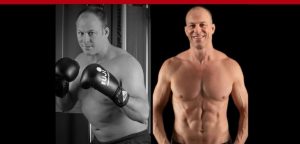You know that exercise does your body good, but you’re too busy and stressed to fit it into your routine.
You know how important it is for your performance to stay fit and healthy, but you can only allocate the minimum time necessary.
And there is so much confusing information out there about fitness and exercising, that it makes it even harder for a high achiever who is on a tight schedule to understand what is the right amount of physical the activity they need in order to get benefits and results.
If you resonate with this, then you should listen to today’s Ted Talk, because you are going to learn some important principles from an expert like Ted who has 23 years of experience working with high achievers like you.
In today’s Ask Ted, he answers the question that we all want to know: What is the minimum activity for high performers to stay fit, manage stress, and improve performance at work?
He reveals the minimum amount of exercise busy entrepreneurs should aim to do at the gym to maintain their physical strength and cardiovascular fitness. He also explains the importance of gathering data, establishing clear goals, and, above all things, being clear about what we are willing to sacrifice to reach them.
Plus, he describes a brief and solid workout routine, how to avoid creating unrealistic expectations, and much more.
You’ll learn:
- How long does it take to start losing fitness?
- Why getting metrics is key to taking action and making good choices
- How DEXA scans can help you make informed decisions
- How do a brief and solid workout routine look like
- What is the difference between your strength and cardiovascular fitness, and how do you maintain them?
- And much more…
Related Episodes:
Ted Talk 159: 5 Mistakes Entrepreneurs Make with Fat Loss (and how to fix them!)
488: The Secret To Staying Healthy And Fit As A Busy Entrepreneur with Dan Roitman
Links Mentioned
Click Here To Chat With My Team
Watch My FREE Body Breakthrough Masterclass
Want To Lose Fat, Transform Your Body & Live Your Best Life In 2023?
I’m offering this blueprint that will lead you to a fail-proof long-lasting result with your body, with your health that will help you reach that potential that you have inside and become your own super self.
If you’re interested in working with me, you can reach out to my chat team and tell them a little bit about your situation and see if working with me would be a good fit for you.
Podcast Transcription: What Is The Minimum Activity For High Performers To Stay Fit, Manage Stress, And Improve Performance At Work? - Ask Ted
Ted Ryce: Welcome back to another Ask Ted episode, and today we’re going to be addressing the question, “What is the best exercise for an executive with a busy schedule?” What is the minimum activity I need to do to reduce stress and improve performance at work? So that’s where we’re going to get into today.
If you want to hear the answer to this question, and you’ve wondered, what is the minimum amount that you need to do to perform and feel your best at work, well, that’s what today’s Ask Ted episode is all about. What is up, my friend, and welcome back to the show? I’m your host, Ted Ryce, coach to executives, entrepreneurs, and other busy professionals.
And this is such an interesting question. And I’m going to twist it around a little bit, because the first thing I want to ask you is, what is your goal? And what do I mean by that? I want to ask you what you’re willing to sacrifice. So, if your goal is to build your business, no matter what, and your health just comes in in third or fourth place, that’s going to be a different answer.
If you’re talking about how do I have the best health, or what is the minimum I need to do to have great health? That’s another question. So, I’m going to answer this in a different kind of way. I want to talk to you about what you need to do, how long it takes to lose your fitness, because that’s what I think is the best way to answer this question in a way that’s actually going to help you.
And the first thing I want to tell you is this: I don’t know. So, here’s the first thing. That’s not actually the first thing. Here’s what I want to tell you: get some metrics. For example, if you’re talking about body fat and muscle mass, get a DEXA scan, measure your muscle mass and measure your body fat. If you’re talking about aerobic conditioning, your cardiovascular fitness, then measure your resting heart rate.
Now I use an Oura ring for that. And this way, we can actually answer your question. And we can also answer what are you willing to sacrifice? Are you with me on that? So just like we need a bass line, we need some metrics, we need some data to say, okay, here’s your current body fat percentage, here’s the amount of muscle you have, here’s your resting heart rate, those are indicative of the three most important things that you can influence when it comes to fitness.
Then we can say, okay, how do these change over time. So if you’re not currently getting a DEXA scan, at least yearly, you’re really doing yourself a disservice. Because you’re not seeing, are you getting fatter over time? Now, you might think, well, I step on the scale, I think I’m pretty sure what’s happening. Or maybe you might think, well, I’m working out really hard, so all that weight that I’m gaining must be muscle, but you don’t really know. And in my coaching program, this is what we start our clients with.
Not all of our clients get DEXA scans, but we really emphasize get a DEXA scan, this is going to tell you what you need to know it’s going to provide some metrics. And just like if you’re an executive running a business, or you’re an entrepreneur, running your own business, or both, knowing the numbers is the key to taking action.
For example, if you’re losing money, then it’s like, what is the least amount of work that I need to do to not lose money? Well, we’re going to have to figure that out. And the answer might be different. So let’s be results oriented. In fact, when I worked with a financial advisor, client of mine, Jeff, shout out to you if you’re listening, Jeff, he said, “One of the best things I took away from working with you Ted was being results oriented.” In other words, you have to use data to make good decisions. Are we all in agreement there? Now that I’ve belabored that point, let’s move on.
When it comes to losing or building fitness, let me tell you like this: it’s a use it or lose it phenomenon, use it or you lose it. That goes with muscle mass, that goes with cardiovascular fitness as well. So, here’s a couple things that we know. Let’s say you’re in good shape, you’re running all the time, or doing… I don’t run, I do elliptical, ride bikes, scuba dive, etc. How long does it take to experience a significant loss of cardiovascular fitness?
And the answer there is about one to two weeks, and we’ll talk about what I think is optimal in a second. But what we know is about after two weeks, let’s say you stop completely. There’s significant loss of cardiovascular fitness. It’s kind of like saying, hey, I went to work for a few months and I made money and then I stopped going to work and then I didn’t make any money.
The same thing is true. With fitness, there needs to be a minimum amount. And the different thing, the difference in business versus fitness here is that with business, there’s a lot of ways to leverage yourself in a way that you don’t have to work much. Now, I haven’t figured that out. So please don’t ask me how to do it. But I know people who are successful, who don’t work as much anymore, because they found a way to leverage to hire other people to delegate, etc, etc.
Again, I’m not the one to tell you how to do that. That’s not my area of expertise. I’m still learning how to do that. So, I can focus on what I’m great at. But there’s a way to do that you can’t leverage other people to do your workouts for you. And that’s one of the reasons why the coaching business is a bit challenging. Because if I could do your workouts for you, if I could eat the right things for you, if I get do it for you, how do you…? What is that? Done For You? DFY?
Coaching would be such an easier thing to sell, but it’s done with you. It’s not “do it yourself; it’s done with you, we have to do it with you. Because ultimately, you can’t pay someone to exercise or eat the right things for you, right? So, there’s always going to be some work on that side. I remember one of my clients, a CEO and business founder, he was like, “I wish I could…? he was very wealthy, lived in a…Drove a new Ferrari, I forget what type.
And then he lived in a penthouse in downtown Miami, it was one of the nicest penthouses I’ve ever seen. And he was quite young, too, in his late 20s. And he was like, “I just wish I could pay you to work out for me.” I was like, “Yeah, I wish you could do that, too, I would charge you a lot. And I would be in shape too. But it just doesn’t work that way.” So just understand it’s a use it or lose it phenomenon.
And it takes about one to two weeks to lose cardiovascular fitness. And it takes about two to three weeks to lose strength and muscle. So we have to maintain with some regular activity. And when we’re talking about this, I can’t give you specifics, because it’s not quite clear, but I will do my best here.
For example, let’s say that you get a DEXA scan. And it’s like, okay, well, how often do you need to train to maintain your strength and your muscle? And the answer here, I think is a little bit more positive, let’s say, than the cardiovascular side, it’s much more work intensive to build and maintain cardiovascular fitness, especially if it’s at a high level, you’ve got to do quite a lot. But with strength training, what I would tell you is you could probably get by on 20 to 30 minutes, two times a week.
What really matters here is what with resistance training. I’ve talked about a lot. Let’s test you right now. What matters with resistance training? What’s the number one thing that you need to do? Do you know? Because if you’re not clear, this is what I test my clients on? Number one is that when I asked my clients this, they answer one of two things, the best students, at least.
They answer, “Well, the first thing is I got to use great form.” And that’s such a nice answer. Great form is extremely important. And the second answer is, “I have to take each set to or close to muscular failure,” to that point where, let’s say, you’re doing a bicep curl. And to do another one, you’d have to throw your body around and you’d have to move your body, you couldn’t do it strictly, you’d have to use some body English, is what they used to call it.
I don’t know what people are calling it—some momentum. So, that’s the thing that you have to do. And if you do that, for each muscle group: your legs, you’re pushing muscles, you’re pulling muscles, you’re going to maintain some muscle, but here’s the thing: it also depends on how much resistance training you’re currently doing.
I’ll give you an example. I went from training in the gym when I was in Lisbon, Portugal, and I moved to a new Airbnb. And I decided you know what, I’m not going to join a gym because I only have three weeks left here. So, I’m just going to skip it all, work out at home. So, I did that. And I had a much better routine in the gym. And as a result, I lost some size in my arms, my arms shrunk, and I asked someone, they told me, “Your arms look a lot different.”
Now. I didn’t measure it, but she’s really into that type of stuff and has a good eye for it. She’s like, “Your arms aren’t quite as big,” and I could feel, there is a difference in the tightness of my shirt sleeves. So, here’s the thing: you can get by with two workouts 30 minutes a week, but there is some nuance here.
If you were in the gym, for, let’s say, as much as I am, an hour or let’s say 45 minutes, four times a week, and you go to two times a week, and for only 30 minutes or 20 minutes, you’re going to lose some no matter what, because again, it’s a use it or lose it phenomenon. But I will tell you this: it’s that first set that matters most. So if you can get yourself to do one set of pushing, pulling, and legs, that’s going to take you maybe 10 minutes or less, and you’re not going to shrink away to nothingness.
So, it depends on where you start as well. Does that make sense? Right, it makes sense. If you’re working out a lot and you cut your workout time in half, you’re going to definitely see some loss of muscle, because you’re not doing the same... It’s like if you cut your work hours in half but you don’t do anything different, you’ll probably notice a big difference in your income.
So, it’s kind of like that, but you can still make money, you can still keep yourself afloat, depending on what your budget is and what your expenses are, etc. But you’re going to notice a loss. So it’s again, it comes back to that question, how much are you willing to lose? But if you’re talking bare minimum, let’s say 20 to 30 minutes, two times a week.
Now, what about cardiovascular fitness, this gets a little trickier. Because if you’re not spending three times a week in the gym, for at least, let’s say 45 minutes, you’re going to lose some cardiovascular fitness, and you’re going to lose over time, you’re not going to feel or perform your best, you’re not going to have the same level of endurance that you would, if you’ve been doing it three times a week.
So, two or three times a week is what you’ll need to, let’s say, maintain a decent level. But if you want to build this even more. And so what I want to tell you, what I hope you’re taking away from this isn’t like a specific prescription here. But the big takeaways I hope that you’re learning right now is that first of all, I need some metrics, I need to measure my debt, I need to get a DEXA scan to measure my body fat, to measure my muscle mass. And I need some way of measuring my resting heart rate.
So, what I do for resting heart rate is I use an Oura ring. But a lot of my clients, they use Apple watches, and that’s fine, too, or Garmin watches. But it’s something that if you’re over 40, which most of my clients are, it’s worth tracking these metrics: your body fat percentage, your lean mass, and your resting heart rate. And then you have to track them over time. And ask yourself, well, how much are you willing to lose?
Another thing that gets complicated here is that the amount of sleep that you get, will also cause you to lose muscle over time. So, if you’re sleeping less than or five hours or less, you’re going to lose muscle over time, especially if you’re not spending a lot of time in the gym. So that’s another factor. And then also stress can influence this as well.
So, folks, there’s no good minimum for everybody. Unless we want to use the CDC activity guidelines. What I’m giving you is more like the—and I’m looking him up now. But I want to tell you what the guidelines here are. So, it’s 150 minutes of moderate intensity, physical activity, and two days of muscle strengthening activity, okay? That is the minimum.
That is not like, hey, you’re going to be in awesome shape. You may be in awesome shape for an American if you do that. But we’re talking about 30 minutes, five days a week and two resistance workouts on top of that. That’s what the government is telling you to do. Okay, and the government, let me tell you, has some pretty low standards, right? But that’s what the CDC recommends.
I’m recommending a little bit less, because I talk to clients all the time. And here’s what I would tell you: you have to the thing here is that you have to understand like what you’re willing to sacrifice. And the second thing here is that for a lot of folks doing 150 minutes of exercise per week, 30 minutes, five days a week of moderate intensity physical activity is, they’re not going to be able to keep that up. That’s what I found. You have to build small.
So, you’ve got to build small if you want to do this, if you’re currently exercising less than the two days of muscle strengthening activity and 150 minutes of moderate intensity physical activity. So, does that make sense? Is that resonating with you? Really important stuff here. So, I think what the CDC asks, I think it’s great. But I also think it’s much more than what your average even executive can do.
I think you need to start smaller and start to focus on consistency. Because if you if doing 30 minutes, five times a week, in addition to two days of muscle workouts or resistance training workouts for 20 to 30 minutes, that’s, like seven workouts, semen 30-minute workouts. If that sounds like a lot for you. And then you try that and you can’t keep it up and you feel deflated or demotivated afterwards and you just want to give up, then you need to work on some type of consistency.
And what I would tell you is this: one thing I don’t like about the way the government approaches this is like something is better than nothing. Doing something always is better than doing nothing. The more activity you can get, in general, the better. But you have to start small, you have to start small, and you have to turn it into a habit. And if you’re doing it too frequently, you’re going to fall off and you’re going to feel bad. If you’re doing it only once a week, you may even forget to do it because it’s just not in your mind enough.
I had a client yesterday, tell me that. I was suggesting doing one workout extra. He’s already doing two days of strength training activity. I said, “What about doing one day of cardio? Because I think based on what you’ve told me...” he’s running a business. I’m like, “I think that a day of cardio can really do a lot to help you.” And what he told me was, “You know what, I think three is too many. But I think one is not enough. I think I’ll forget. So let’s start with two and that’ll be what we do.”
And I said, “Excellent.” And so what I would tell you is this, and I asked him, “Well, on a scale of 1 to 10, how confident are you that you’ll be able to do the two workouts with your trainer and the two cardio workouts on your own?” And he said, I’m pretty confident. So I’m going to give you a nine.” And I said, “Excellent.” That’s what we’re looking for. It’s okay if you miss one every once in awhile, but the goal is to hit two.
And that’s an example of how we work out a schedule that someone feels like they can stick to because if you try to say, well, I’m going to do those seven workouts that the CDC recommends. And let’s say you only do two or three, you feel like, oh, this is too much for me. So, I’m going to give up. And that’s what we’re trying to avoid.
When those negative feelings come up for you because you have this unrealistic standard—which I think it is seven 30 minute workouts is for most people, then you’ve got to say, okay, I know that if I set this seven 30 minute workout thing, seven 30 minute workouts per week goal and if I only get two or three, I’m going to feel like a loser, and I’m going to feel like giving up, you need to start breaking it down into smaller chunks. You need to start breaking it into smaller chunks.
And you may even say, you know what, forget about cardiovascular activity, let’s start just to reduce the time that you sit. So, in other words, look at your step count, and get more steps or find a hobby that just encourages you to move more. For example, I got a client of mine, he plays pickleball. And he’s not doing it because of the exercise. He’s doing it because he really likes it.
I’m about to go scuba diving. Now I’m not going to get a lot of steps in it’s going to be swimming. And actually, there’s not that much swimming involved with scuba diving, but there’s a lot of isometric holding. And it is very challenging, you’re burning a lot of calories, not a ton, but you’re burning a lot of calories when you do scuba diving. So those are just some examples.
So I want to ask you this: what is the big takeaway that you’re getting from listening to this episode today? That’s what I want you to take away from today and get actionable on it, take action. Make sure you do something with it. What can you start with? What do you feel like you should set as a goal? How much exercise do you feel like you should do based on listening to this today? That’s what I want to leave you with. Time for me to go diving. Hope you enjoyed it. Have an amazing weekend. Love you lots, and speak to you soon.
Sign up to receive email updates
Enter your name and email address below and I'll send you periodic updates about the podcast.








